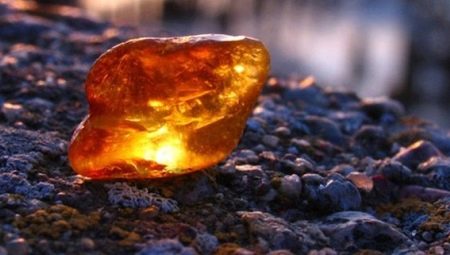Amber can be called one of the most common and popular ornamental stones in the world - in our area, it is completely recognizable and in demand. However, most people know a little about him, therefore it is worth getting to know this material better.
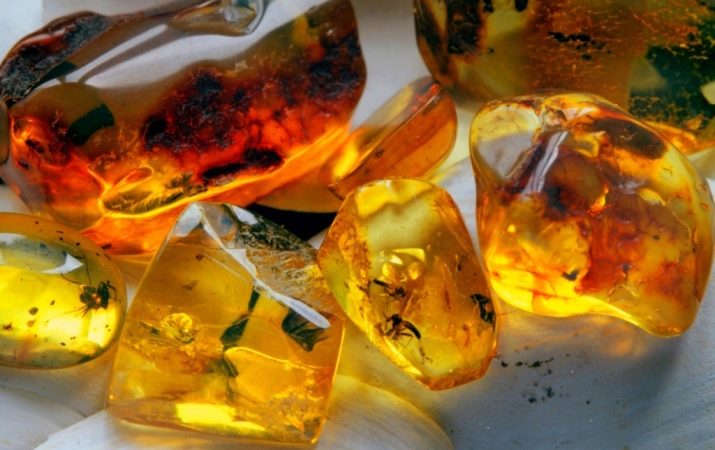
Description
Amber is a petrified resin of conifers that has been lying in the earth for tens of millions of years. Talking about its significance for humans, most people would say that this is a beautiful craftsmanship, but in some regions of its mass production local residents do not at all consider this resource as something especially valuable and sometimes even use it instead of rosin for soldering. However, in Russia amber is often called the “Baltic gold” - this poetic term describes how the substance looks and how those who have not encountered it in everyday life relate to it.
This stone consists of a good 70% carbon, the rest in approximately equal proportions is hydrogen and oxygen. Since in the original this substance has an organic origin, its formula is, of course, more complicated - sulfur, nitrogen and ash are also included in the composition.
If you describe the appearance of amber, you need to mention that this substance does not form crystals - it belongs to frameless polymers. Its color can fluctuate within the gamut available for ordinary fresh coniferous resin - most often these are shades from yellowish to brown through reddish tones. At the same time, specific stones of a colorless, milky or slightly greenish tone come across.Transparency does not differ in homogeneity - it can be either almost transparent amber or one that does not let light through at all. It is characteristic for all pebbles specific resin gloss.
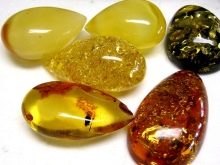
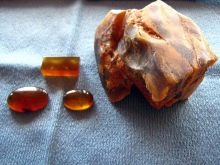

The density of amber is most often in the range of 1.05-1.09 grams per cubic centimeter, but sometimes this figure reaches 1.3 grams per volume. This stone is not particularly hard: even if you don’t take it with your bare hands, it can be polished without any problems. Friction helps the pebble to become electrified, acquiring a negative charge.
At room temperature, amber is a solid, but when it reaches a temperature of 150 degrees it begins to gradually soften. The melting point of the substance is not precisely determined and is about 280-320 degrees. Any kind of this stone is highly flammable.
The variety and uncertainty of many characteristics of amber are caused by the fact that it changes under the influence of external forces. First of all, it oxidizes in the open air, reacting with oxygen, which makes it brittle, and can change color and chemical composition. In addition, the initial data can also change - the properties of the stone depend on which tree the resin was from and how long it was stored in the ground.
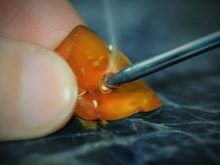
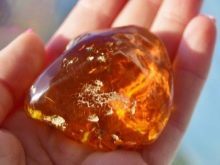
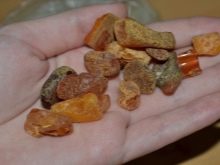
Origin history
The origin of amber has been fanned by legends for a long time, because you rarely see a stone that does not give crystals, burns in fire and melts near it. The etymology of the name of such a substance in different languages says a lot about how it came to be known about amber in a particular country and what local people thought about it.
So, in modern Romance and many Germanic languages, amber has the name amber, which can be traced to the ancient Arabic consonant word - from this we conclude that in the Middle East this substance has been known since ancient times. Today, there is a continuous sandy desert and it is hard to believe that once coniferous forests could grow here. The Arabs themselves did not believe in such an option either - they guessed that they had solidified liquid, but considered the stone to be dew, and not coniferous resin.
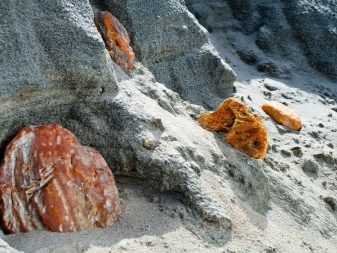
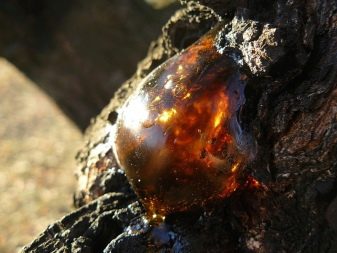
The German-speaking peoples, who in the Middle Ages belonged to almost the entire Baltic, were most admired for the fact that amber is able to burn, and even emits a characteristic aroma. Without thinking twice, they called it “Bernstein”, which can be considered an abbreviation for the German phrase “combustible stone”. Today, the derived word "burshtyn" is called amber Poles, Ukrainians and Belarusians.
In Greece, amber was called an electron in honor of the star Electra, located in the constellation Taurus. Even in ancient times, local residents noticed the ability of a stone to electrify when rubbed - in fact, the modern word "electricity" just came from the name of this substance.
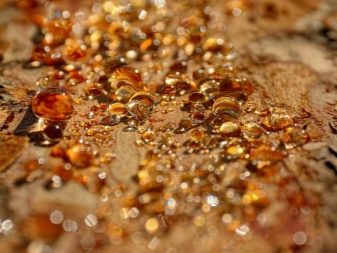
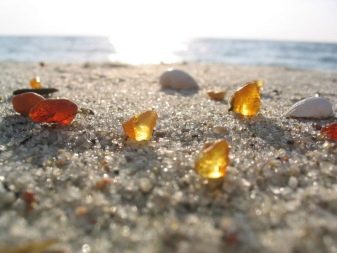
In Ancient Russia, where the official language had a lot of borrowings from Greek because of the common religion, amber was called “elektr”, sometimes “elektron” for a long time. For a less educated majority who did not speak Greek, this name was too complicated, because some scholars believe that the legendary alatyr-stone, aka “white-combustible stone”, is precisely amber.
As for the modern Russian name, its etymology goes back to the Lithuanian word gintaras, for the first time “entar” was mentioned in a written source in 1551. Many Slavic languages borrowed the same word from the Lithuanian language through Russian.
Interestingly, both the ancient Greek and Lithuanian names for the stone are elevated to the local form of the word “protect,” since magical properties were attributed to the unusual substance, allowing it to be used as an amulet.
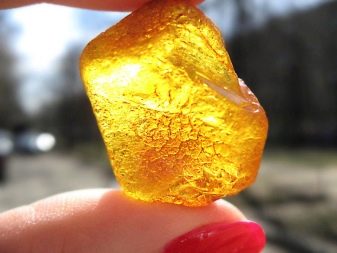
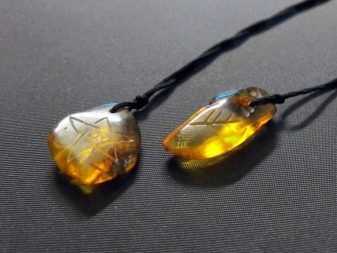
Modern poetic names like “the gift of the Sun” or “tears of the sea” once again indicate that in any country and in any era, amber was perceived as something completely unusual, but always with a positive connotation.
If we turn not to legends, but to history, it turns out that for the manufacture of various products this stone has been used for several thousand years. Even in the Neolithic times, rings, buttons and many other useful gizmos were made from amber in the Baltic States. Interestingly, the crown of the ancient Egyptian pharaoh Tutankhamun, whose age reaches almost 3.5 thousand years, is decorated with amber, among other jewelry, the scientist believes that he was brought from the shores of the Baltic Sea. Already at that time in the Mediterranean region was established full trade in this unusual stone.
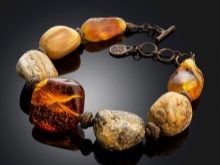
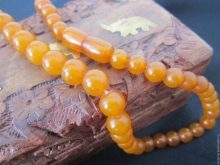
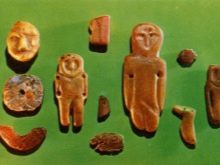
For several millennia, amber processing was a popular craft on the eastern and southern coasts of the Baltic Sea until the Teutonic Order reigned here in the 13th century and decided that it was too valuable a raw material to allow everyone to trade it. Since then, processing of such stones has become a state affair, special serfs were engaged in collection, and processing at home was prohibited - all raw materials were purposefully exported to other cities. The exclusive right to trade in such goods had to be obtained from the state, because the handicrafts subsided for a long time.
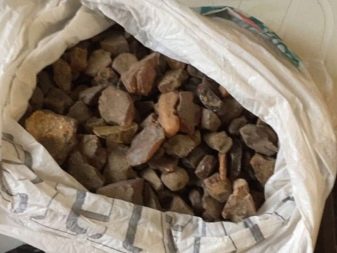

Place of Birth
At the dawn of civilization, the main European source of amber was a deposit on the territory of present-day Denmark, but it was exhausted in ancient times. Already in the ancient Roman period, the main region for the extraction of amber gems could already be considered the Amber Coast in the Baltic, located today in the Kaliningrad region of Russia, as well as in neighboring Lithuania and Latvia. It is generally accepted that today up to 90% of all deposits of this stone are concentrated here, there is immediately a unique amber plant engaged in the extraction of such gems.
In Ukrainian Polesie amber is also quite a lot. Local Rovno amber is also widely known. The local deposits belong to the Baltic-Dnieper sub-province of the Eurasian Amber-bearing province, so the “gifts of the Sun” here are echoes of the neighboring Baltic states.



If we talk about the rest of Eurasia, then there is relatively little amber. In Europe, limited reserves of such raw materials are found in the Carpathian mountains and Sicily, in Asia - in the north of Siberia, the Far East and Burma.
In addition, some of these gems can be mined in North America. Today, the main deposits of amber in the western hemisphere are located in the Dominican Republic and Mexico, in addition, episodic finds of such stones are known in the north of Canada and the USA, as well as in Greenland.
Among other things, ancient authors have repeatedly mentioned that earlier amber extraction was possible even in India and Africa. Nowadays, in these regions (as in Mexico), digging is another type of petrified resin, which most scientists urge not to confuse with amber. However, another group of specialists suggests including these regions among the amber-bearing provinces due to the general similarity of the stones.
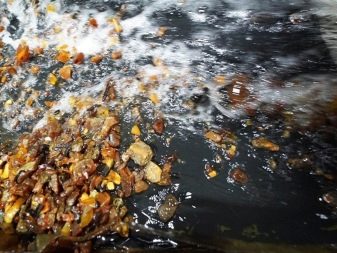
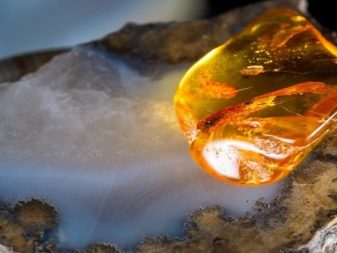
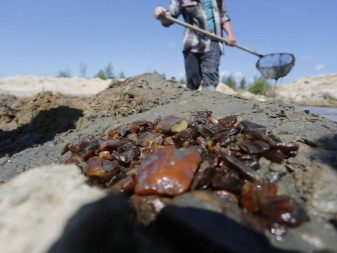

Colors and varieties
The widespread belief that amber is purely yellow in color is fundamentally wrong - modern experts distinguish as many as four hundred different colors. Yellow and orange species are simply much more common, therefore all these poetic epithets about the “gifts of the Sun” belong to them.
It should be understood that relatively high prevalence reduces demand for such a pebble - the gem of any atypical shade is valued more. At the same time, it would be foolish to evaluate a piece of amber purely by its color - the cost is determined both by size, and by craftsmanship, and, in particular, by the presence of inclusions.

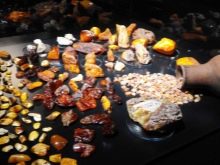
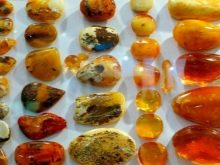
Classic Baltic amber, as most of our fellow citizens are accustomed to thinking, resembles wax in a hint, and thin sheets of this substance also do not lag behind in transparency.At the same time, yellow gems of any tone, including those with a red tint, are also included in the list of classic options.
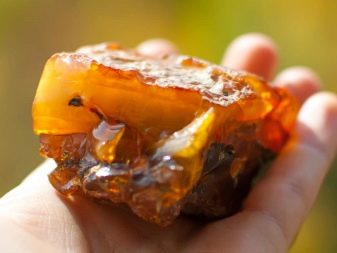
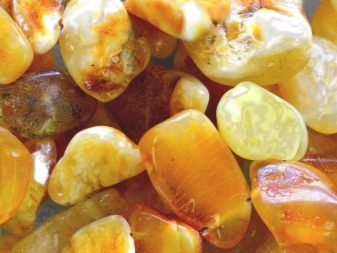
This stone also happens to be emphasized in red and even cherry color, and this is a claim to originality. Such a beautiful shade is caused by the fact that ordinary prehistoric resin, apparently due to forest fires, went through the calcination procedure. Outwardly, such a nugget resembles a ruby, therefore it was highly valued in all ages. Poetic Chinese and Japanese called it "dragon's blood", only the highest state officials could afford such a large-sized decoration.
The top three colors include milky white amber, but it is interesting that the substance of which it consists does not happen to be white. Such a color is just a visual effect, just in the thickness of a yellowish hue there are abundant interspersed air and water bubbles, which give the stone a whitish color.
Unusual amber shades such as green and blue are even less common. The first of these options also arises purely due to impregnations, this time - of plant particles, or even soil. With blue gems, the biggest confusion is that scientists still cannot explain where this shade came from, and they offer obscure theories about optical illusion.
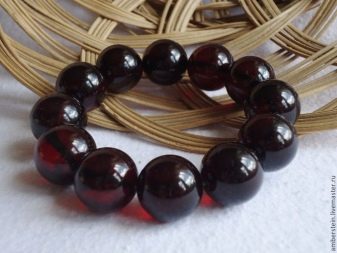
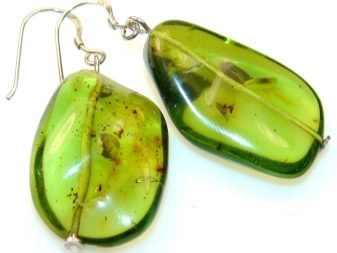
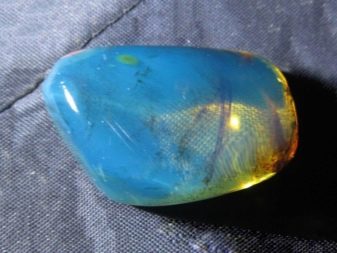
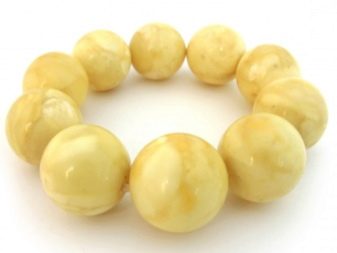
It should be noted that pebbles do not always turn out to be monophonic - a pure tone with high transparency is generally a rarity. But a significant part of amber has certain opacities in its thickness.
In some samples, these opacities are found only outside, since there is practically no transparency - such an instance is called landscape. It doesn’t always look really beautiful, but sometimes a properly polished bead reminds one of the planets of the Solar System.

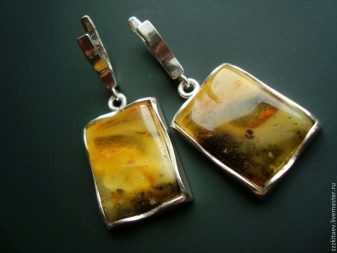
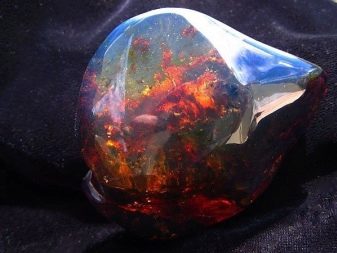
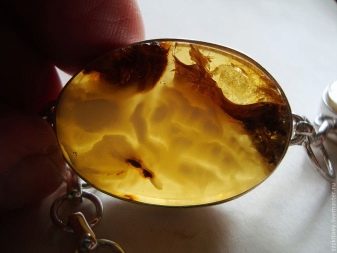
If you want to find a truly exclusive sample, focus on amber, in which a certain prehistoric insect has frozen. It is quite difficult to get such a copy, because it is very rare, and scientists, museums and the powerful people of the world prey on it.
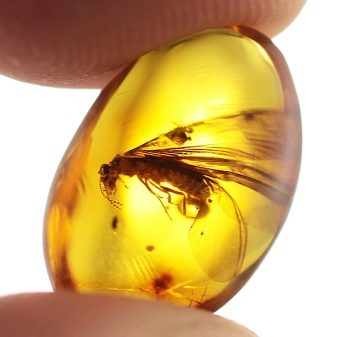

The properties
Like any other material, known since ancient times and considered expensive, amber is fanned by many legends. Due to this, magical and healing properties were attributed to him in different eras. Some of them were confirmed, others remained unproven, but only the owner of the stone decides what to believe and what not.
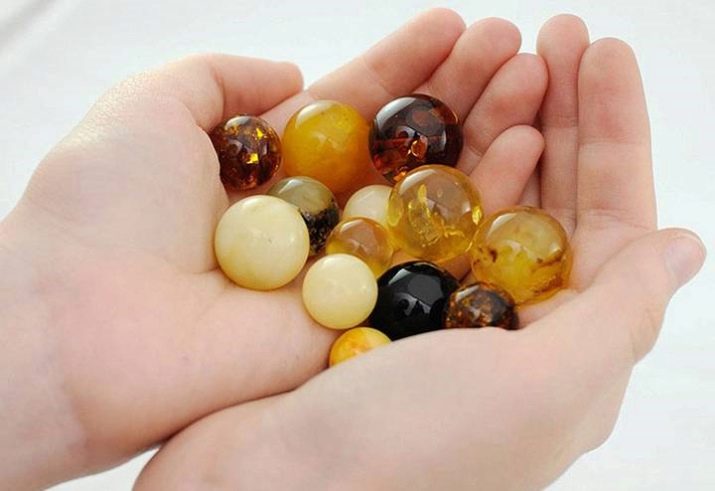
Magical
Amber is often associated with the Sun, and the celestial luminary itself is considered to be a symbol of happiness, joy and fun. The sun stone is a priori suitable for being a talisman - at different times it was attributed to it both strengthening health and protection from enemies. It is believed that such an amulet is suitable for people who are inclined to decide with their heart and not with their mind, because it will not interfere with representatives of creative professions and just optimists. In addition, the stone contributes to luck in all respects, increases intuitive abilities, and also provides peace to the owner’s dwelling. According to esoteric experts, there is a whole list of positive properties inherent only in amber.
This stone:
- calms and warms, literally penetrating the soul;
- constantly stored somewhere in a casket, protects the home from criminals and natural disasters;
- helps expectant mothers to give birth without complications, and those who have already got a baby, ensure the health of the baby;
- It guarantees a good mood if you constantly wear it on yourself, while a large piece is enough just to squeeze in your hand to get a powerful positive charge;
- contributes to the preservation of female youth;
- chases away bad thoughts and night thoughts, if put in advance under a pillow - however, for this purpose it is suitable exclusively in its raw form;
- purifies and clarifies both the body and the soul;
- helps its master survive any, even the most difficult grief.

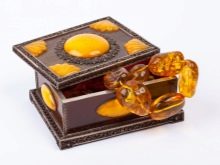

Medical
In ancient times, it was commonly believed that the healing properties of amber are universal, that is, they are useful in any situation and with an ailment of any nature. Ancient healers found a lot of benefit in using this stone, not thinking about how it heals, but sincerely believing that not a single disease can resist the effects of such a drug.
By the way, some useful properties of this substance have been proven today, and traditional medicine all this time continued to use it, without needing any evidence.
- It is believed that the constant wearing of an amber bracelet helps to speed up metabolism and helps cleanse the body of all that is superfluous. By this logic, such an accessory will definitely come in handy for a person who keeps himself fit, or who wants to lose weight.
- Succinic acid is sold in modern pharmacies. This is a biostimulant of natural origin, which in terms of efficiency is able to compete with popular power engineers, about the dangers of which a lot has been written. Such a drug is sometimes recommended for use by people engaged in intense mental labor.
- Small amber chips are used by many pharmaceutical companies in the drug manufacturing process. For example, tincture on such an unusual ingredient is considered very effective in the fight against various pulmonary diseases and colds.
- The smoke emitted during the burning of amber contains all the same useful substances as the tincture described in paragraph above. For this reason, amber inhalations, if you find a pebble and do not regret burning it, can also be useful.

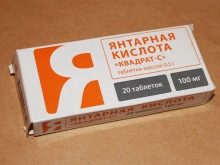

It is noted that their use can be productive in the treatment of asthma or chronic cough.
Who is it for?
Amber is very popular among women as a beautiful and stylish jewelry, especially since for many men it is not a big problem to buy it - this gem, which is also not very cheap, is not quite enough for real gemstones. At the same time, representatives of the weaker sex are often fond of astrology and tend to select jewelry in accordance with the rules of this science. Then they should know that “Sun stone” is best suited for the signs of the zodiac, whose element is fire - these are Aries, Leo and Sagittarius.
Since this stone is positive in any case, the same esotericists note the possibility of wearing it for representatives of absolutely any zodiac sign. For some reason, only Taurus is offended by the favor of the “Baltic gold” - it’s not that he is forbidden to wear amber jewelry, just the esoteric effect of it will tend to zero. If for active representatives of fire signs this stone can be an excellent additional stimulant, then for earth signs its wearing can result in further aggravation of indifference.
Airy and watermarks can wear such an ornament both for beauty and for a specific healing effect.
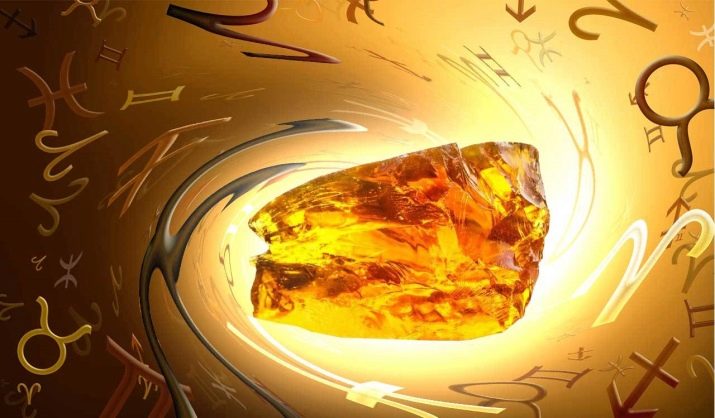
There is a point of view that amber "chooses" its owner on its own - if suddenly this gem does not suit you, you yourself will want to wear it.
How to distinguish from a fake?
Real amber is not enough for everyone, because today, as in the case with many other stones, there is artificial amber. Outwardly, he really looks like, and sellers are not always in a hurry to tell the buyer that he is facing a fake, and demand as much for a piece of plastic as for a natural stone. Naturally, modern trinkets do not have any special properties, therefore you need to know the differences between amber and any other materials so as not to become a victim of scammers.
- Intrusion of air bubbles in prehistoric resin is a normal phenomenon, but as a rule there should not be many of them.In the industrial production of inexpensive artificial amber, manufacturers usually do not care about purchasing an expensive airtight mixer with the function of suctioning air, therefore there will be especially many such fake bubbles.
- A perfectly even tone of amber beads is a clear sign of product falsification. At the very least, nature should not have conceived this, because amber is not a living creature and does not need to disguise itself from someone. Therefore, most pieces of this stone, which are not yet free from extraneous impurities, have a characteristic haze. For a manufacturer of cheap goods, drawing complex and unique patterns is an unnecessary task, and this can help catch a fraudster.
- Amber has an organic origin and has an amazing property of keeping warm. It is never cold, unlike plastic, because it is also a solar stone. Despite the fact that this substance is relatively soft, it still does not work to scratch it with a fingernail. If you accidentally “spoiled” the goods to the seller, trying to scratch it with your fingernail and leaving a clearly visible scratch, then there can be no question of naturalness.
- Real natural stone weighs surprisingly little, so even massive-looking beads in your hand will turn out to be surprisingly light. With plastic, and even more so with glass, the difference will be very obvious - they will be much harder and will cause some discomfort when worn. To distinguish the original from a fake by this criterion, a preliminary experience of wearing proven amber is desirable - then you will definitely not be mistaken in what you are offered.
- Despite the fact that the gem has lain in the earth for tens of millions of years, in essence it remains the same coniferous resin that it was originally.
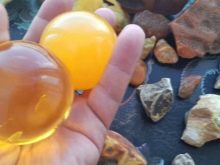
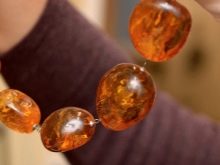
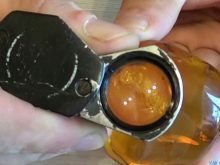
Being polished, well-worn and saturated with foreign smells, it may not have its own aroma, but this is only at first glance. You just need to rub a little amber product in your hands, and if it has a natural origin, you will definitely feel a characteristic smell.
Application
Most often, amber is used in jewelry and for the manufacture of souvenirs. In the latter case, both an unprocessed, and a pressed or fused version of the gift may come in handy. Masters of processing make real miracles from amber - figurines, paintings, icons and much more.

In industry, this stone has found particular application in industries such as pharmaceuticals, perfumes, food, as well as for the production of sandpaper and some varnishes - for example, they cover the famous Stradivarius violins. In the old days, amber could be used as an electrical insulator.
To the already mentioned medicinal properties, you can add another application in medicine. Even in Ancient Egypt, it was used for mummification, and today it is made of various accessories for blood transfusion, because it protects living flesh from destruction.

Care
The difficulty of handling amber is that, having a natural origin, it tends to age quickly, which makes it cloudy and becomes brittle. Here are a few subtleties of how to maximize the life of your favorite jewelry:
- Amber does not like heat or cold, and suffers especially severely at sudden changes in temperature;
- perfumes and any household chemicals can harm amber jewelry, even a tiny drop of perfume can harm a stone;
- this gem is not very strong, even a relatively weak blow can split it;
- due to the softness of the material and its dislike of detergents, it is extremely undesirable to touch the product with dirty hands, fat is a particular danger to amber;
- In a strange way, the “sun stone” cannot be stored for a long time under the sun's rays - a dark box is better for this, but sometimes it is just necessary to “recharge” it, otherwise it will fade;
- fresh air provokes oxidation of the surface of the pebble, due to which it becomes brittle and may become cracked;
- amber, unlike many other stones, is never stored in bags - the fabric is not able to protect the nugget from impact and splitting;
- for the above reason, amber products are never stored together, for each choose a separate box;
- the best cleaning method is regular wiping with a dry soft flannel or woolen cloth after each dressing;
- if you wash amber, then only in cold or slightly warm water, from additives, for example, let us say ammonia, but the use of soap is prohibited;
- ideally, pebbles are cleaned with special means, but if they are not, you can soak it in a salted aqueous solution;
- after washing, the product must be wiped dry and polished with olive oil.

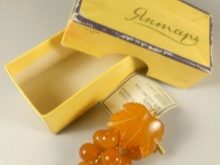

The most expensive jewelry should not be wet at all - they are only wrapped with wet wipes.
Look at the properties of amber in the next video.
